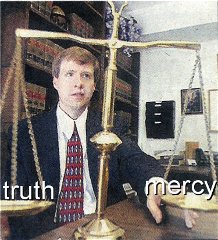What's in a Logo?
 Our nation’s pledge ends with the words, “One nation, under God, indivisible, with liberty and justice for all.” The interplay of God, liberty and justice may seem commonplace in the United States but in many ways the connection of these principles can be traced back to Raphael’s portrait of Justice.
Our nation’s pledge ends with the words, “One nation, under God, indivisible, with liberty and justice for all.” The interplay of God, liberty and justice may seem commonplace in the United States but in many ways the connection of these principles can be traced back to Raphael’s portrait of Justice.
Raphael is one of the three great high Renaissance artists along with Michelangelo and Leondardo Da Vinci. In 1509 Raphael was commissioned by Pope Julius II to paint the Stanza della Segnatura, a suite of rooms likely used as the pope’s office and library. Raphael wrote to Leo X his desire to reconcile and restore through art the ‘good antique period’ and Christian doctrine. On the ceiling of the library Raphael painted four images representing poetry, philosophy, theology and justice. Such a combination was without precedent in the ancient world.

 On one side of Justice Raphael painted the fall symbolizing the effect of sin in making perfect justice impossible. On the other side Raphael painted the Judgment of Solomon which represented the need for wisdom in executing justice.
On one side of Justice Raphael painted the fall symbolizing the effect of sin in making perfect justice impossible. On the other side Raphael painted the Judgment of Solomon which represented the need for wisdom in executing justice.The walls contained four great frescoes representing the four major areas including ‘disputa’ for theology, involving an intellectual discussion of the trinity, the sacraments and the gospels. The school of Athens, for philosophy, illustrating the seven liberal arts and the great philosophers. Apollo and the nine muses, for poetry and the arts, and a wall for justice. The top of the Justice wall depicted three women representing the cardinal virtues of Fortitude, Prudence and Temperance. Surrounding them are three winged cherubs representing charity, gathering fruits from an oak, hope, carrying a flaming torch and faith, pointing to the sky. To the left of the door is a painting of Justinian receiving the civil law and to the right Pope Gregory IX receiving the canon law.
Raphael was the first to bring into harmony the spirits of Antiquity and Christianity. The Library of Congress in Washington D.C. follows this same pattern.
Prior to Raphael images of justice could be found in the Greek goddess Themis who carried a sword and scales, the Egyptian goddess Maat who carried a sword and the Roman goddess Justitia. This goddess was depicted with sword and scales in Raphael’s time. Raphael likely drew upon older images of justice from AD 22-23 where she was depicted as regal wearing a diadem. Raphael’s image of justice uniquely blended the spirits of ancient art, philosophy and theology. Raphael robed his justice in purple robes of royalty and provided her with a crown. The earlier diadem had symbolized freedom and the crown likely expanded on this notion indicating freedom through royalty.

The angels are unique as well and the two winged angels each carry a stone tablet of the law (IVS). The other symbols are more recognizable with Justice holding balanced scales symbolizing that justice should be available to all and the sword representing the power and authority of justice.
It is difficult to miss the influence of Rafael’s justice on Frédéric-Auguste Bartholdi’s sculpture of Lady Liberty. The flame of hope found on Raphael’s wall of justice, the tablet,  the robes and crown blend elements of justice and liberty. While not initially part of the statue, Emma Lazarus’s 1903 poem brings together the concepts of liberty and justice well by concluding, “Give me your tired, your poor, Your huddled masses yearning to breathe free, The wretched refuse of your teaming shore. Send these, the homeless, tempest-tost, to me, I lift my lamp beside the gold door!”
the robes and crown blend elements of justice and liberty. While not initially part of the statue, Emma Lazarus’s 1903 poem brings together the concepts of liberty and justice well by concluding, “Give me your tired, your poor, Your huddled masses yearning to breathe free, The wretched refuse of your teaming shore. Send these, the homeless, tempest-tost, to me, I lift my lamp beside the gold door!”
Administer Justice exist to serve the poor. Our calling comes from a blending of civic and Christian responsibility. Our name comes from Scripture which states, “This is what the LORD almighty says, ‘Administer true justice; show mercy and compassion to one another. Do not oppress the widow, the fatherless, the alien or the poor. In your hearts do not think evil of each other.”
Administer Justice recognizes as a nation under God we must pursue liberty and justice for all. Equal justice under law must not be a mere message carved in stone on the façade of our Supreme Court building. Rather we believe it is an ideal to be actively pursued through mercy and compassion for those in need. We believe our logo represents this ideal well. It is our prayer that we may one day fully be one nation, under God, indivisible with liberty and justice for all.


0 Comments:
Post a Comment
<< Home